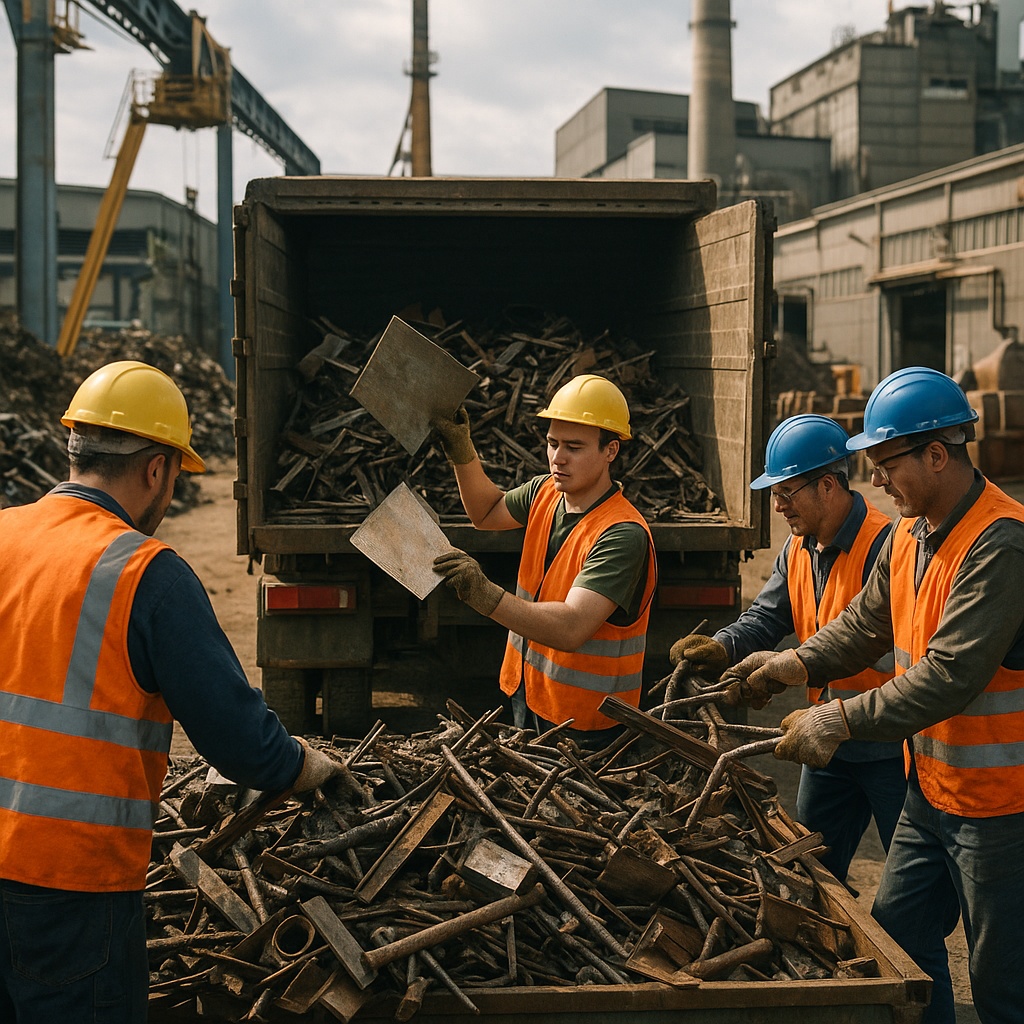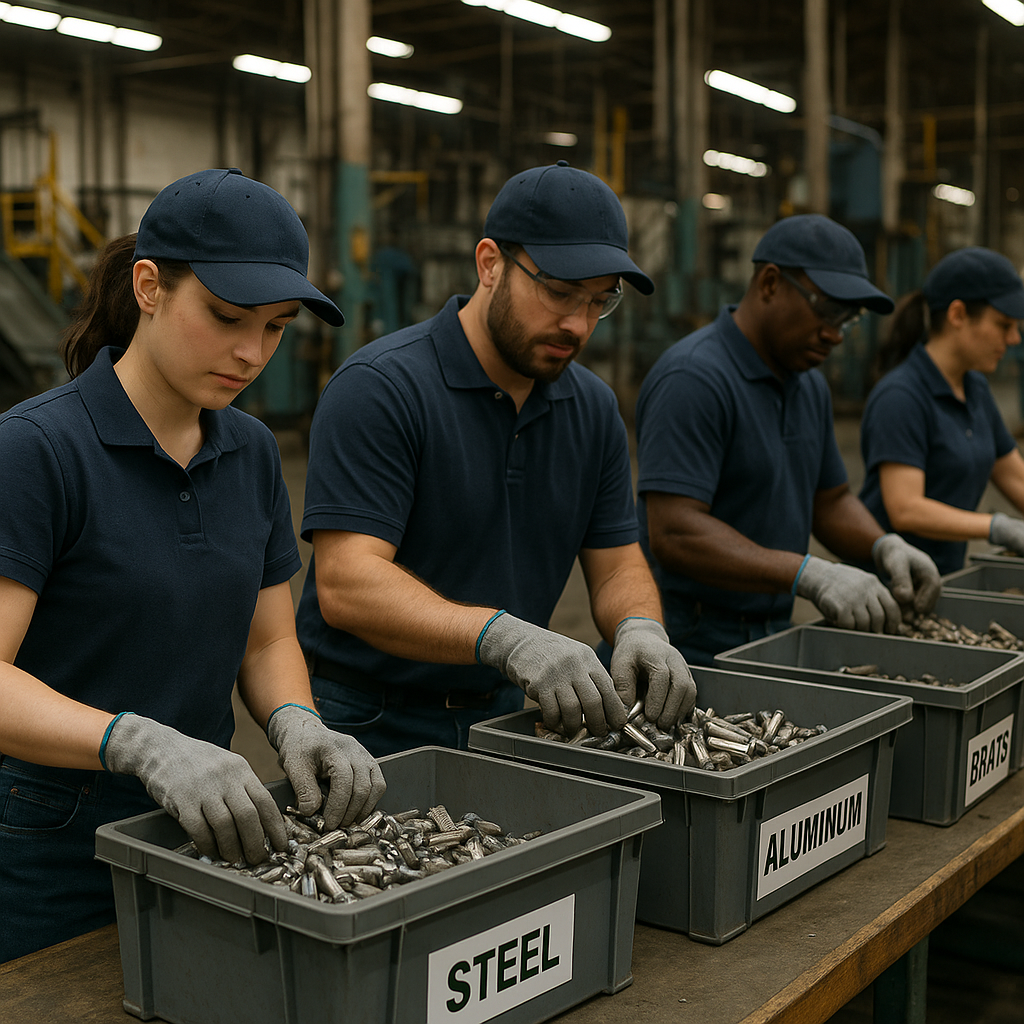5901 Botham Jean Blvd, Dallas, TX 75215
Scrap Metal Collection for Factories: Everything You Need to Know
August 13, 2025Manufacturing operations consistently generate metal waste, from shavings and offcuts to obsolete equipment and machinery parts. Factories produce large amounts of recyclable metal materials each day, and scrap metal collection offers a systematic approach to managing this industrial byproduct.
Scrap metal collection for factories involves the organized process of gathering, sorting, and processing metal waste from manufacturing and industrial operations. This crucial service helps facilities manage their waste streams while recovering valuable materials that would otherwise end up in landfills.
The process typically includes collecting both ferrous metals (containing iron), such as steel, and non-ferrous metals like aluminum, copper, and brass. These materials hold significant value in the recycling market, making proper collection not just environmentally sound but also financially beneficial for factories.
How Does the Scrap Metal Collection Process Work?

The scrap metal collection process entails a structured series of steps aimed at maximizing recovery efficiency. Material handling systems facilitate systematic collection from various factory zones, streamlining workflows for industrial recycling operations.
Here is an overview of each phase of the scrap metal collection and processing journey:
1. Collection Phase
Collection starts at designated points throughout manufacturing facilities. Workers gather metal scraps from production lines, maintenance areas, and waste bins. Large industrial sites often use color-coded bin systems to separate ferrous metals like steel from non-ferrous materials like aluminum and copper at the source.
Efficient collection requires proper training for all personnel handling scrap materials. Collection frequency varies based on production volume and scrap generation rates. Some facilities utilize magnetic lifting systems to handle heavy ferrous materials safely.
2. Sorting and Separation
Metal sorting is a critical step that directly impacts the value of recovered materials. Sorting methods range from simple magnetic separation to advanced technologies, such as:
- Magnetic separation for distinguishing ferrous from non-ferrous metals
- Visual inspection to identify different metal types
- Density-based sorting using water or air systems
- Spectrometer analysis for precise alloy identification
Proper sorting prevents cross-contamination and maintains material purity. Metals with similar appearances but different compositions require careful separation to preserve their recycling value. Modern facilities often use sensor-based sorting systems capable of processing hundreds of tons daily.
3. Processing and Preparation
Once sorted, metals are prepared for transport and recycling. This process includes:
Shredding, which breaks larger metal pieces into smaller, more manageable fragments. Industrial shredders can handle everything from thin sheet metal to thick structural components. Compacting reduces volume through hydraulic presses that create dense metal bales. Some facilities employ specialized equipment for specific materials, like wire stripping machines for copper recovery.
Size reduction significantly lowers transportation costs and enhances furnace efficiency during recycling. Clean, properly sized scrap commands premium pricing from recycling facilities.
4. Transportation to Recycling Centers
Processed scrap requires efficient transport systems to move it from collection sites to recycling facilities. Logistics considerations include:
Trucks transport most scrap over short to medium distances. Rail systems are economical for long-distance transport of bulk materials. Loading equipment ensures safe and efficient transfer between transportation modes. Documentation tracks material quantities, types, and the chain of custody throughout the transportation process.
Transportation represents a significant cost factor in the recycling equation. Strategic planning of collection routes and load optimization helps minimize these expenses.
5. Recycling Facility Processing
At specialized recycling facilities, scrap undergoes its final transformation through:
Further sorting to ensure material purity, melting in furnaces designed for specific metal types, refinement to remove remaining impurities from the molten metal, and casting that transforms liquid metal into ingots, sheets, or other forms for manufacturing use.
This final processing stage completes the recycling loop, turning what was once waste into valuable manufacturing inputs. The energy savings from recycling versus primary metal production can reach 95% for aluminum and 60% for steel.
Industrial recycling systems continue to evolve with technological advances. Modern facilities use artificial intelligence, robotics, and advanced sensing technologies to improve sorting accuracy and processing efficiency. These enhancements help reclaim more material while reducing energy consumption throughout the recycling steps.
What Are the Benefits of Scrap Metal Collection for Factories?

Factories generate significant amounts of metal waste during daily operations. This scrap metal, rather than being a burden, is a valuable resource that can benefit your facility in multiple ways. Implementing a structured scrap metal collection program transforms waste management from a cost center into a strategic operation.
Modern manufacturing facilities that implement systematic scrap collection programs can recover between 15-20% of material costs through effective recycling. This direct financial return is just the beginning of the advantages these programs offer.
Cost Savings on Waste Disposal
Traditional waste disposal methods incur substantial costs for factories. Landfill tipping fees continue to rise nationwide, and transportation expenses for waste removal add to operational overhead. By diverting metal scrap from the general waste stream, factories immediately reduce these disposal costs.
Every ton of metal diverted from landfills represents direct savings on tipping fees, which typically range from $50 to $100 per ton, depending on your location. For large manufacturing operations, these savings can quickly amount to thousands of dollars annually.
Revenue Generation Through Metal Recovery
Beyond cost avoidance, scrap metal collection creates a new revenue stream. Materials like aluminum, copper, steel, and brass hold significant value in recycling markets. Scrap yards pay competitive prices for these materials, converting waste into a valuable commodity.
For example, a medium-sized factory producing aluminum components might generate several tons of aluminum scrap monthly. At current market rates, this translates to substantial revenue that directly impacts the bottom line. Even steel scrap, while less valuable per pound than non-ferrous metals, generates meaningful returns due to its high volume.
Environmental Sustainability Benefits
The environmental advantages of scrap metal recycling extend far beyond your facility. Recycling aluminum saves up to 95% of the energy required for primary production. Steel recycling reduces energy consumption by approximately 60%, while copper recycling saves about 85% of the energy needed for mining.
These efficiency gains translate directly into reduced carbon emissions. Recycling one ton of aluminum prevents about 9 metric tons of CO₂ emissions. This environmental benefit provides quantifiable metrics for sustainability reporting and supports broader corporate environmental goals.
Compliance with Environmental Regulations
Regulatory requirements for waste management continue to tighten across industries. Many jurisdictions now mandate recycling for certain materials and require detailed documentation of waste handling practices. A structured scrap metal program helps ensure compliance with these regulations.
Professional scrap management provides complete material movement documentation, certified weight records, transportation compliance verification, and processing facility certification. These elements are particularly valuable for manufacturers with ISO 14001 environmental management systems or facilities working under strict regulatory oversight.
Enhanced Corporate Reputation
Customers and stakeholders increasingly consider environmental practices when evaluating business relationships. A visible commitment to responsible material management strengthens your brand image and demonstrates corporate responsibility.
According to a Manufacturing Institute survey, over 70% of industrial customers now consider environmental practices when selecting suppliers. By implementing and promoting your scrap metal recovery program, you position your facility as an environmentally responsible operation.
Workspace Optimization and Safety
Efficient scrap collection systems improve workplace organization by eliminating improvised storage methods. Strategic placement of collection containers reduces congestion in work areas and minimizes material handling requirements.
These improvements directly impact workplace safety by reducing trip hazards, decreasing handling of sharp edges, and maintaining clear pathways. OSHA statistics indicate that improper material storage contributes to approximately 15% of workplace injuries in manufacturing settings.
Process Integration and Efficiency
When properly implemented, scrap collection becomes integrated into standard operating procedures rather than functioning as a separate activity. Collection containers positioned at points of scrap generation, service schedules aligned with production cycles, and material segregation incorporated into standard procedures all contribute to operational efficiency.
Most manufacturing operations implementing systematic scrap management programs report significant efficiency improvements, with many achieving return on investment within 3-6 months through reduced handling costs and improved space utilization.
How Can Factories Optimize Their Scrap Metal Collection?

Effective scrap metal collection is a crucial component of sustainable manufacturing. Factories generate significant amounts of metal waste during production processes. When managed properly, this waste becomes a valuable resource rather than a disposal challenge. Implementing strategic collection systems helps factories recover maximum value while supporting environmental sustainability goals.
Strategic sorting forms the foundation of efficient scrap metal management. Placing designated collection containers at points where waste is generated prevents contamination and reduces handling requirements. Metal types should be separated immediately to maintain their value and recyclability.
Implement Systematic Sorting Procedures
Analyze your production processes to identify points where scrap metal is generated. Place appropriate containers at these locations with clear labels indicating which metals belong in each bin. Use color-coding for quick and intuitive identification by workers.
Separate ferrous metals (containing iron) from non-ferrous metals (like aluminum, copper, and brass) since they have different recycling processes and values. A simple magnet test works effectively—ferrous metals are magnetic, while non-ferrous metals are not. This basic sorting step can significantly increase the value of your recycled materials.
Keep high-value metals like copper and brass separate from lower-value materials. Remove contaminants such as plastic attachments, rubber components, and excessive oils before placing metals in collection containers. Clean metals command higher prices and require less processing at recycling facilities.
Invest in Employee Training
Your sorting system’s effectiveness depends on how well your staff understands it. Develop comprehensive training programs that teach employees to identify different metal types and follow proper sorting protocols. Regular training sessions ensure new employees learn the system and existing staff stay updated on any changes.
Create clear visual guides showing examples of common scrap items and their correct sorting category. Post these guides near collection points for quick reference. Consider appointing recycling champions within different departments to monitor compliance and answer questions.
Explain the financial and environmental benefits of proper sorting to build employee buy-in. When workers understand how their actions contribute to company sustainability goals and potentially improve profitability, they become more engaged in the process.
Partner with Specialized Recycling Companies
Selecting the right recycling partner significantly impacts the success of your scrap metal program. Look for companies with specific industrial experience and a track record of working with manufacturing facilities. Evaluate potential partners based on their processing capabilities, transportation options, documentation systems, and pricing transparency.
Request on-site assessments from prospective recyclers to develop customized collection solutions for your facility. Professional recyclers can recommend container types, placement strategies, and collection frequencies based on your production volume and available space.
Establish clear service agreements that outline pickup schedules, material handling requirements, and payment terms. Regular service prevents accumulation of materials that can create safety hazards or occupy valuable production space. Some recycling companies offer rebate programs or volume-based pricing that can significantly increase your return on recycled materials.
Consider On-Site Processing Equipment
For factories generating large volumes of scrap metal, investing in on-site processing equipment may be economically viable. Balers compact loose materials into dense bundles that require less storage space and are more efficient to transport. Shredders reduce the size of bulky items and prepare them for further processing.
Evaluate the potential return on investment for processing equipment based on your current scrap volume and handling costs. While the initial investment may be substantial, reduced transportation costs and higher material values often justify the expense for high-volume operations.
Start with basic equipment and scale up as your program develops. Many recycling partners offer equipment leasing options that reduce initial capital requirements while still providing operational benefits.
Implement Tracking and Analysis Systems
Establish systems to track the volume and types of scrap metal generated by different production processes. This data helps identify opportunities for waste reduction and process improvements.
Document all material shipments with weights, classifications, and values. Review this information regularly to spot trends and anomalies that might indicate problems in your production or sorting processes. Some recycling partners provide digital platforms that simplify tracking and reporting.
Set specific recovery targets and monitor progress toward these goals. Regular performance reviews help identify both successful practices and areas needing improvement. The most effective scrap metal programs continuously evolve based on operational data and changing market conditions.
Compare your recovery rates against industry benchmarks to assess program effectiveness. Manufacturing operations with systematic scrap management typically achieve 15-20% higher material recovery compared to those with ad hoc collection methods.
By implementing these systematic approaches to scrap metal collection, factories can transform waste management from an operational cost into a potential revenue stream. The combination of proper sorting, employee engagement, professional partnerships, appropriate equipment, and data-driven management creates a comprehensive program that delivers both environmental and financial benefits.
Conclusion: Embracing Efficient Scrap Metal Collection

Scrap metal collection presents a strategic opportunity for factories to transform waste into valuable resources. Through organized collection programs, manufacturers can divert metal waste from landfills while generating additional revenue. The environmental benefits are clear, as recycled metals require significantly less energy to process than virgin materials and emit fewer greenhouse gases.
In addition to environmental gains, factories with effective scrap metal collection systems enjoy economic advantages with reduced waste disposal costs and potential revenue from selling recyclable materials. These sustainable practices also bolster corporate responsibility, meeting the growing market and regulatory demands for eco-friendly manufacturing processes.
Ready to enhance your factory’s metal recycling program? Contact Okon Recycling at 214-717-4083 for specialized scrap metal collection solutions tailored to your manufacturing operation’s unique needs.
